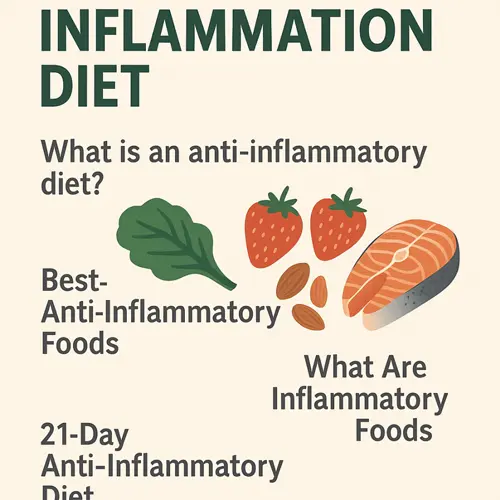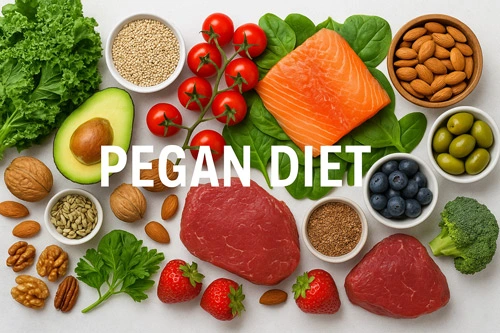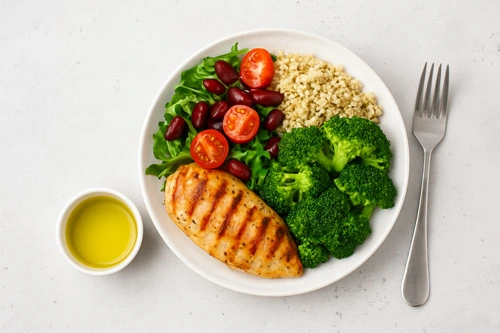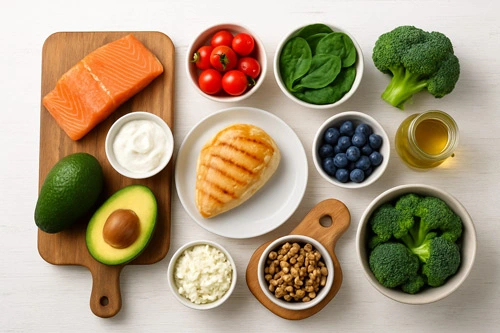✅ Introduction
In recent years, chronic inflammation has been increasingly recognized as a silent contributor to a wide range of serious health issues, including heart disease, diabetes, obesity, and autoimmune disorders. Inflammation itself is not inherently bad — in fact, it’s a natural immune response that helps the body heal from injury or infection. However, when inflammation becomes chronic and persistent, it can turn into a hidden threat, quietly damaging tissues and organs over time.
That’s where the anti inflammation diet comes into play. Instead of relying solely on medications to manage inflammation, many people are turning to nutrition as a powerful, natural tool for healing. But what is an anti inflammatory diet, exactly? In simple terms, it’s a dietary approach that focuses on eating whole, nutrient-dense foods known to reduce inflammation and avoiding those that tend to trigger or worsen it.
By embracing an anti-inflammatory way of eating, individuals can take proactive steps toward improving their overall health, boosting energy, enhancing mental clarity, and even managing weight more effectively. In this article, we’ll explore what the anti inflammation diet is, how it works, which foods to eat and avoid, and how you can start building your own plan today.
✅ What Is an Anti-Inflammatory Diet?
To understand the anti-inflammatory diet, it’s important to first understand what inflammation is. Inflammation is your body’s natural defense mechanism. When you’re injured or exposed to harmful invaders like bacteria or viruses, your immune system activates an inflammatory response to protect and heal the affected area. This acute inflammation is a short-term, necessary process — it helps you recover.
But problems arise when inflammation becomes chronic, meaning it stays activated over time even without any clear threat. This low-grade, ongoing inflammation has been linked to the development of many modern diseases, including type 2 diabetes, cardiovascular conditions, cancer, arthritis, and even depression.
An anti-inflammatory diet is a nutritional approach designed to minimize chronic inflammation in the body. It emphasizes consuming whole, unprocessed foods rich in antioxidants, fiber, healthy fats, vitamins, and phytonutrients — all of which support a healthy immune system and reduce inflammatory processes. At the same time, it eliminates or limits foods that are known to promote inflammation, such as refined sugars, processed meats, trans fats, and excess alcohol.
Although the term “anti-inflammatory” is also used in the context of medications (like ibuprofen or corticosteroids, which fall under the Anti-inflammatory – Drug class), a diet-based approach is non-invasive, sustainable, and has positive side effects like weight management, better digestion, and enhanced energy levels.
In short, if you’ve been wondering what is an anti inflammatory diet, think of it as a lifestyle strategy that uses food as a form of preventive medicine. Instead of treating the symptoms of inflammation with drugs, this diet aims to reduce its root cause through everyday eating habits — turning your meals into a long-term wellness tool.
✅ Benefits of an Anti-Inflammatory Diet
Following an anti-inflammatory diet offers a wide range of health benefits that go far beyond simply reducing inflammation. By incorporating nutrient-rich, whole foods that combat chronic inflammation, you can experience improvements in multiple aspects of your health and well-being.
1. Reduced Risk of Chronic Diseases
Chronic inflammation is a common underlying factor in many serious conditions such as heart disease, type 2 diabetes, arthritis, certain cancers, and Alzheimer’s disease. Studies show that adhering to an anti-inflammatory eating pattern can help lower the risk of developing these illnesses by controlling inflammatory markers in the body.
2. Supports Healthy Weight Loss
Inflammation often contributes to weight gain and difficulty losing weight by interfering with hormone function and metabolism. An anti-inflammatory diet for weight loss focuses on foods that promote fat burning and reduce insulin resistance, making it easier to shed excess pounds naturally and maintain a healthy weight.
3. Improved Energy and Mood
Chronic inflammation has been linked to fatigue and mood disorders such as depression and anxiety. Eating a diet rich in antioxidants and essential nutrients helps support brain health and energy production, leading to better mental clarity and emotional balance.
4. Enhanced Digestive Health
Inflammation in the digestive tract can cause discomfort, bloating, and other gastrointestinal issues. An anti-inflammatory diet encourages consumption of fiber-rich foods and probiotics that nurture a healthy gut microbiome, improving digestion and nutrient absorption.
5. Better Skin Health
Many people notice clearer, healthier skin after switching to an anti-inflammatory diet. Foods high in antioxidants help fight oxidative stress and inflammation, which are common contributors to acne, eczema, and premature aging.
6. Long-Term Wellness and Disease Prevention
Unlike medication-based approaches that treat symptoms temporarily, following an anti-inflammatory diet plan supports your body’s natural healing mechanisms and helps maintain overall health for the long term.
In summary, embracing an anti-inflammatory diet is not just about reducing inflammation — it’s about transforming your lifestyle for a healthier, more vibrant life.
✅ Anti-Inflammatory Foods: What to Eat
One of the cornerstones of an effective anti inflammation diet is knowing which foods help reduce inflammation and promote healing. Incorporating a variety of these nutrient-dense foods into your daily meals can make a significant difference in your overall health.
Top Anti-Inflammatory Foods
-
Leafy Green Vegetables
Spinach, kale, Swiss chard, and collard greens are rich in antioxidants and vitamins like A, C, and K. These nutrients help neutralize free radicals that cause inflammation. -
Berries
Blueberries, strawberries, raspberries, and blackberries contain powerful antioxidants called flavonoids, which have been shown to reduce markers of inflammation. -
Fatty Fish
Salmon, mackerel, sardines, and trout are excellent sources of omega-3 fatty acids, which are well-known for their anti-inflammatory properties. Omega-3s help lower levels of inflammatory proteins in the body. -
Nuts and Seeds
Almonds, walnuts, flaxseeds, and chia seeds provide healthy fats, fiber, and plant-based proteins that support immune health and reduce inflammation. -
Olive Oil
Extra virgin olive oil is rich in monounsaturated fats and polyphenols, both of which have potent anti-inflammatory effects. -
Spices and Herbs
Turmeric, ginger, cinnamon, garlic, and rosemary are natural anti-inflammatory agents often used in cooking to add flavor and health benefits. -
Green Tea
This antioxidant-rich beverage contains catechins, which have been linked to lower inflammation and improved metabolic health.
Why These Foods Matter
These best anti inflammatory foods contain bioactive compounds such as antioxidants, polyphenols, and omega-3 fatty acids that combat oxidative stress and modulate immune responses. Including a colorful variety of these foods in your meals maximizes their protective effects.
✅ What Are Inflammatory Foods to Avoid
While incorporating anti-inflammatory foods is crucial, equally important is knowing which foods to limit or avoid because they promote inflammation and can undermine your health goals.
Common Inflammatory Foods
-
Refined Carbohydrates
White bread, pastries, white rice, and other highly processed carbs can cause rapid spikes in blood sugar, leading to increased production of inflammatory molecules. -
Added Sugars and High-Fructose Corn Syrup
Excessive sugar consumption is linked to higher levels of cytokines, which are proteins that promote inflammation. Soda, candies, baked goods, and many processed foods are major culprits. -
Processed and Red Meats
Sausages, hot dogs, bacon, and other processed meats contain preservatives and saturated fats that contribute to inflammation and have been associated with chronic diseases. -
Trans Fats
Artificial trans fats, found in some margarine, fried foods, and packaged snacks, increase bad cholesterol and inflammation dramatically. -
Excessive Alcohol
Drinking large amounts of alcohol can increase inflammation and damage the liver and other organs. -
Certain Vegetable Oils
Oils high in omega-6 fatty acids (like corn, soybean, and sunflower oils) may promote inflammation if consumed excessively without a proper balance of omega-3s.
Tips to Reduce Inflammatory Foods
-
Choose whole grains over refined grains
-
Read labels carefully to spot hidden sugars and trans fats
-
Limit processed and fast foods
-
Opt for healthy fats like olive oil and avocado instead of inflammatory oils
-
Moderate alcohol intake
By minimizing these inflammatory foods, you create a foundation for your anti inflammation diet to be most effective, allowing your body to heal and maintain optimal health.
✅ Anti Inflammatory Diet Plan – How to Start
Starting an anti inflammation diet plan may seem overwhelming at first, but with simple steps and practical guidance, you can gradually transform your eating habits and enjoy lasting health benefits.
Step 1: Focus on Whole, Unprocessed Foods
Base your meals on whole fruits, vegetables, nuts, seeds, whole grains, and lean proteins like fatty fish and legumes. Avoid processed foods, artificial additives, and refined sugars.
Step 2: Incorporate Anti-Inflammatory Staples Daily
Include plenty of leafy greens, berries, turmeric, ginger, and olive oil in your meals. These are your daily allies against inflammation.
Step 3: Plan Balanced Meals
Aim for a balance of macronutrients: complex carbs, healthy fats, and quality protein. This helps stabilize blood sugar and reduce inflammatory spikes.
Sample 7-Day Anti-Inflammatory Diet Plan
| Day | Breakfast | Lunch | Dinner | Snack |
|---|---|---|---|---|
| 1 | Oatmeal with berries & flaxseed | Quinoa salad with kale & chickpeas | Grilled salmon with steamed broccoli | Handful of walnuts |
| 2 | Green smoothie with spinach & turmeric | Lentil soup with turmeric & garlic | Stir-fried tofu & mixed vegetables | Apple slices with almond butter |
| 3 | Greek yogurt with chia seeds & blueberries | Brown rice bowl with grilled chicken & avocado | Baked sweet potato & sautéed greens | Carrot sticks with hummus |
| 4 | Whole grain toast with avocado & tomato | Mixed bean salad with olive oil & lemon | Mackerel with quinoa & steamed spinach | Mixed berries |
| 5 | Chia pudding with coconut milk & cinnamon | Vegetable curry with brown rice | Grilled turkey breast with asparagus | Handful of pumpkin seeds |
| 6 | Smoothie bowl with kale, banana & walnuts | Salad with mixed greens, nuts & salmon | Stir-fried shrimp with broccoli & garlic | Celery sticks with peanut butter |
| 7 | Scrambled eggs with spinach & tomatoes | Roasted vegetable wrap with hummus | Baked trout with quinoa & green beans | Dark chocolate (small piece) |
Step 4: Stay Hydrated and Practice Mindful Eating
Drink plenty of water throughout the day. Eat slowly and listen to your body’s hunger and fullness cues.
Step 5: Combine Diet with Lifestyle Changes
Exercise regularly, manage stress, get enough sleep, and avoid smoking to maximize the anti-inflammatory effects.
By following this anti inflammatory diet plan, you’re not just eating healthier—you’re giving your body the tools it needs to reduce inflammation, heal, and thrive.
learn more: Plant-Based Diet: A Complete Guide to Benefits, Foods & Weight Loss
✅ Anti Inflammatory Diet Recipes
Trying out some delicious, easy-to-make recipes is a great way to embrace your anti inflammation diet. Here are a few beginner-friendly dishes packed with anti-inflammatory ingredients.
1. Turmeric Ginger Smoothie
Ingredients:
-
1 cup unsweetened almond milk
-
1 banana
-
1 teaspoon ground turmeric
-
1/2 teaspoon grated fresh ginger
-
1 tablespoon chia seeds
-
1/2 cup frozen berries (blueberries or strawberries)
-
A pinch of black pepper (to enhance turmeric absorption)
Instructions:
Combine all ingredients in a blender and blend until smooth. Enjoy this antioxidant-rich smoothie to start your day with a natural inflammation-fighting boost.
2. Quinoa & Kale Salad with Lemon-Tahini Dressing
Ingredients:
-
1 cup cooked quinoa
-
2 cups chopped kale (massaged with a little olive oil)
-
1/2 cup cherry tomatoes, halved
-
1/4 cup toasted walnuts
-
1/4 cup chopped cucumber
-
Dressing: 2 tablespoons tahini, juice of 1 lemon, 1 tablespoon olive oil, salt and pepper to taste
Instructions:
Mix quinoa, kale, tomatoes, walnuts, and cucumber in a bowl. Whisk together dressing ingredients and toss with the salad. This nutrient-dense salad is loaded with fiber, healthy fats, and antioxidants.
3. Baked Salmon with Garlic and Rosemary
Ingredients:
-
2 salmon fillets
-
2 cloves garlic, minced
-
1 tablespoon fresh rosemary, chopped
-
2 tablespoons olive oil
-
Salt and pepper to taste
-
Lemon wedges for serving
Instructions:
Preheat oven to 400°F (200°C). Place salmon fillets on a baking sheet. Drizzle olive oil and sprinkle garlic, rosemary, salt, and pepper over the fillets. Bake for 12-15 minutes or until cooked through. Serve with lemon wedges.
4. Lentil & Vegetable Stew
Ingredients:
-
1 cup dried green lentils
-
1 onion, chopped
-
2 carrots, diced
-
2 celery stalks, diced
-
3 cloves garlic, minced
-
1 teaspoon turmeric
-
1 teaspoon cumin
-
4 cups vegetable broth
-
2 cups chopped spinach
-
Salt and pepper to taste
Instructions:
In a large pot, sauté onion, carrots, celery, and garlic until soft. Add lentils, turmeric, cumin, and vegetable broth. Bring to a boil, then simmer for 30 minutes. Stir in spinach and cook until wilted. Season with salt and pepper.
5. Berry Chia Pudding
Ingredients:
-
1/4 cup chia seeds
-
1 cup unsweetened almond milk
-
1 teaspoon vanilla extract
-
1/2 cup mixed berries
-
Honey or maple syrup to taste (optional)
Instructions:
Mix chia seeds, almond milk, and vanilla in a jar. Refrigerate overnight. Before serving, top with fresh berries and a drizzle of honey if desired.
✅ Indian Anti Inflammatory Diet
The rich culinary heritage of India offers many naturally anti-inflammatory ingredients and recipes, making it an excellent model for those seeking a flavorful yet health-supportive diet. The anti inflammatory diet Indian style emphasizes whole, plant-based foods combined with powerful spices that have been used for centuries for their healing properties.
Key Anti-Inflammatory Spices in Indian Cuisine
-
Turmeric (Haldi):
Contains curcumin, a potent compound known for its strong anti-inflammatory and antioxidant effects. Turmeric is a staple in most Indian dishes and is often consumed with black pepper to increase absorption. -
Ginger (Adrak):
Known for soothing digestive issues and reducing inflammation, ginger is commonly used fresh or dried in curries, teas, and chutneys. -
Cinnamon (Dalchini):
Helps regulate blood sugar and reduce inflammatory markers, cinnamon is frequently added to both savory and sweet dishes. -
Garlic (Lahsun):
A natural anti-inflammatory and immune booster, garlic enhances flavor and nutrition in many Indian recipes.
Typical Indian Anti-Inflammatory Foods
-
Lentils and Legumes:
Rich in fiber and plant-based protein, dals and legumes form the foundation of many Indian meals. -
Vegetables:
Leafy greens like spinach (palak), fenugreek (methi), and mustard greens (sarson) are widely used and packed with antioxidants. -
Whole Grains:
Brown rice, millet (bajra), and whole wheat (atta) provide slow-digesting carbohydrates that prevent blood sugar spikes. -
Yogurt (Dahi):
A good source of probiotics that supports gut health, which is closely linked to inflammation control.
Vegetarian and Vegan Friendly Options
Indian cuisine naturally offers a variety of anti inflammatory diet plan vegetarian dishes, such as:
-
Palak Dal (Spinach Lentil Curry)
-
Vegetable Sambar
-
Chickpea Curry (Chana Masala)
-
Mixed Vegetable Stir-Fries with Turmeric and Mustard Seeds
These meals are flavorful, nutritious, and easy to prepare, making the Indian anti-inflammatory diet a great choice for vegetarians and vegans alike.
✅ Anti Inflammatory Diet for the UK Lifestyle
Adopting an anti inflammation diet uk means tailoring your food choices to what’s available and popular in the UK, while still maintaining the core principles of reducing chronic inflammation.
Shopping Smart in the UK
-
Choose Local and Seasonal Produce:
British supermarkets and farmers’ markets offer a wide range of fresh, seasonal fruits and vegetables that are naturally anti-inflammatory. For example, berries, kale, broccoli, and root vegetables are commonly available. -
Look for Organic Options When Possible:
Organic fruits and vegetables reduce exposure to pesticides and chemicals that might contribute to inflammation. -
Opt for Whole Grains:
Swap white bread and pasta for whole grain or rye alternatives, which are rich in fiber and beneficial nutrients.
Common UK Foods That Fit the Anti-Inflammatory Diet
-
Oats: A breakfast staple, oats are high in fiber and antioxidants. Overnight oats with berries and nuts make a perfect anti-inflammatory start to the day.
-
Salmon and Other Fatty Fish: Widely available in UK supermarkets, oily fish provide essential omega-3s that combat inflammation.
-
Root Vegetables: Carrots, sweet potatoes, and parsnips are nutrient-dense and versatile for roasting, mashing, or stewing.
-
Nuts and Seeds: Walnuts, flaxseeds, and chia seeds can easily be added to cereals, salads, or snacks.
Adapting Recipes for UK Palates
You can enjoy classic British dishes with an anti-inflammatory twist. For example:
-
Use olive oil or rapeseed oil instead of butter for cooking
-
Add turmeric or ginger to soups and stews
-
Include plenty of vegetables with meals like shepherd’s pie or casseroles
Meal Planning and Preparation
Busy lifestyles in the UK often call for quick and easy meals. Preparing batch meals or using slow cookers can help you stick to an anti-inflammatory diet even on hectic days.
By making mindful choices and embracing local foods, following an anti inflammatory diet uk can be both delicious and effective for your health.
learn more: Diet Soda: Benefits, Risks, Ingredients & Weight Loss Insights
✅ 21 Day Anti-Inflammatory Diet Challenge
Committing to a 21 day anti-inflammatory diet challenge is a practical way to reset your eating habits and experience the powerful benefits of reducing chronic inflammation.
What to Expect
During these three weeks, you can anticipate improvements such as:
-
Reduced joint pain and stiffness
-
Increased energy levels and mental clarity
-
Better digestion and regularity
-
Weight loss or maintenance of a healthy weight
-
Improved sleep quality
Sample 21-Day Plan Outline
-
Week 1: Focus on eliminating inflammatory foods — cut out added sugars, processed snacks, and refined carbs. Begin incorporating more fruits, vegetables, and healthy fats.
-
Week 2: Increase intake of anti-inflammatory spices like turmeric and ginger. Try new recipes and add fatty fish or plant-based proteins.
-
Week 3: Fine-tune your meals to balance macronutrients and practice mindful eating. Track your progress and adjust as needed.
Tips for Success
-
Meal Prep: Plan and prepare meals ahead to avoid last-minute unhealthy choices.
-
Hydration: Drink plenty of water throughout the day.
-
Track Your Progress: Use a journal or app to note symptoms, energy, mood, and any changes in weight.
-
Stay Motivated: Join online communities or find a buddy to share the challenge.
Tools and Resources
Many apps and websites offer meal plans, shopping lists, and recipes tailored for anti-inflammatory diets, which can help simplify your journey.
By completing this 21 day anti-inflammatory diet challenge, you’ll build habits that support long-term wellness and reduce the risk of chronic diseases caused by inflammation.
✅ Conclusion
In conclusion, embracing an anti inflammation diet is a powerful step towards protecting your body from the damaging effects of chronic inflammation. By understanding what is an anti inflammatory diet and focusing on nutrient-rich whole foods such as leafy greens, berries, fatty fish, nuts, and healing spices like turmeric and ginger, you can significantly improve your overall health.
Avoiding common inflammatory foods — including refined sugars, processed meats, and trans fats — further supports your body’s natural ability to heal and thrive. Whether you choose to follow a simple daily anti-inflammatory diet plan, try delicious recipes, or take on a structured 21 day anti-inflammatory diet challenge, the key is consistency and mindful eating.
Remember, the journey to wellness is a marathon, not a sprint. Small, sustainable changes add up over time, helping you reduce inflammation, boost energy, manage weight, and enhance mental clarity.
Start today by incorporating a few anti-inflammatory foods into your meals and gradually build your way to a healthier, more vibrant life.






